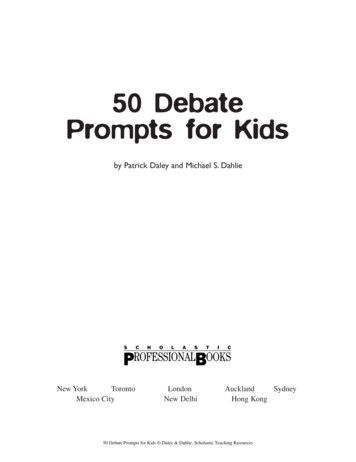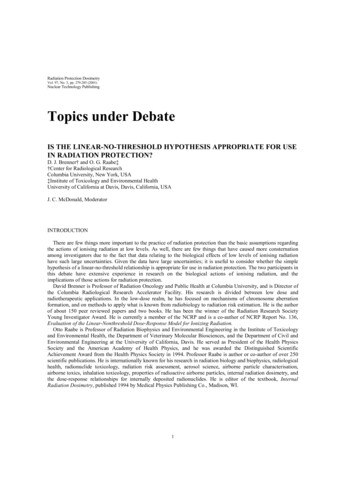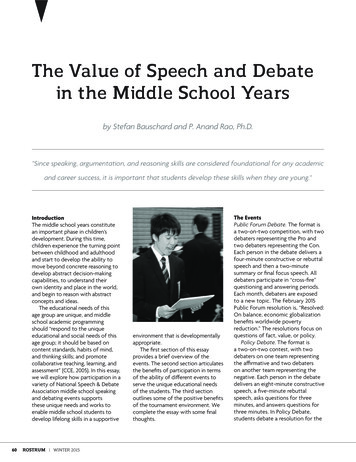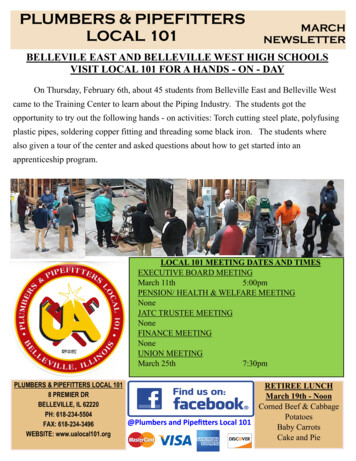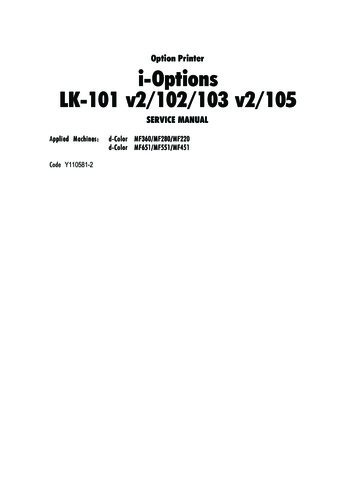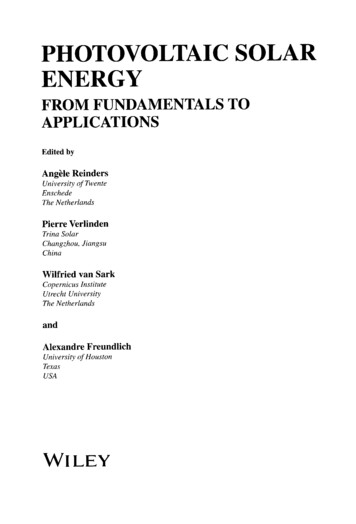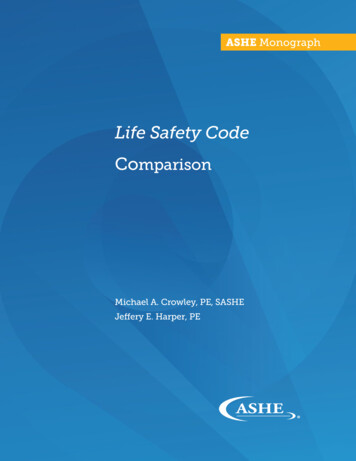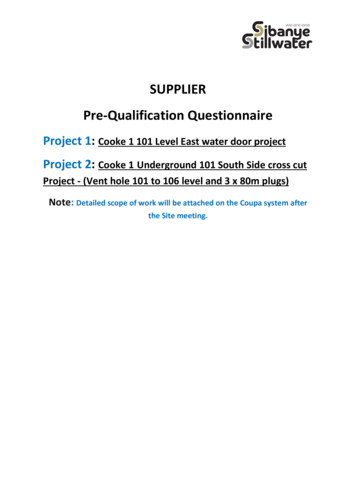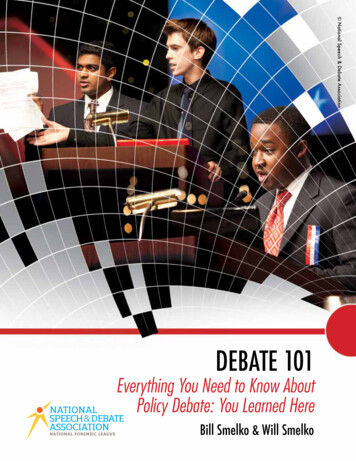
Transcription
National Speech & Debate AssociationDEBATE 101Everything You Need to Know AboutPolicy Debate: You Learned HereBill Smelko & Will Smelko
DEBATE 101Everything You Need to KnowAbout Policy Debate: You Learned HereBill Smelko & Will Smelko NATI ONAL S PEE CH & DEB AT E A S S OCIAT ION
DEBATE 101: Everything You Need to Know About Policy Debate: You Learned HereCopyright 2013 by the National Speech & Debate Association All rights reserved.Published byNational Speech & Debate Association125 Watson Street,PO Box 38,Ripon, WI 54971-0038 USAPhone: (920) 748-6206Fax: (920) 748-9478info@speechanddebate.orgNo part of this publication may be reproduced, stored in a retrieval system, or transmitted in any form or by any means,now known or hereafter invented, including electronic, mechanical, photocopying, recording, scanning, informationstorage and retrieval, or otherwise, except as permitted under Section 107 or 108 of the 1976 United States CopyrightAct, without the prior written permission of the Publisher.The National Speech & Debate Association does not discriminate on the basis of race, color, national origin, religion, sex,age, gender identity, gender expression, affectional or sexual orientation, or disability in any of its policies, programs, andservices.Printed and bound in the United States of America
ContentsChapter 1: Debate Tournaments . . . . . . . . . . . . . . . . . . . . . . . . . . . . . . 1Chapter 2: The Rudiments of Rhetoric . . . . . . . . . . . . . . . . . . . . . . . . . . . 5Chapter 3: The Debate Process . . . . . . . . . . . . . . . . . . . . . . . . . . . . . .11Chapter 4: Debating, Negative Options and Approaches, or, THE BIG 6 . . . . . . . . . .13Chapter 5: Step By Step, Or, It’s My Turn & What Do I Do Now? . . . . . . . . . . . . . .41Chapter 6: Ten Helpful Little Hints . . . . . . . . . . . . . . . . . . . . . . . . . . . .63Chapter 7: Public Speaking Made Easy . . . . . . . . . . . . . . . . . . . . . . . . . .71Chapter 8: Conclusion . . . . . . . . . . . . . . . . . . . . . . . . . . . . . . . . . .83 NATI ONAL S PEE CH & DEB AT E A S S OCIAT ION
Chapter 1Debate TournamentsCompetitive High School Debate involves preparing for, and attending Tournaments, where you will debate against teams from other schools about the meritsof a National High School Debate Resolution. This year, the Resolution is:Resolved: The United States federal government should substantially increase itsexploration and/or development of space beyond the Earth’s mesosphere.At Tournaments, you will have 4-8 roundsNational Resolution (called the Affirmativeof competition. You will “switch sides,” so thatCase and Plan) and whether or not a judgeif in Round 1 you are Affirmative, in Roundshould vote for the Affirmative Team or for2 you will be Negative. A round involves twothe Negative Team. The competition is in-opposing teams of debaters making sound,tense, and success requires adaptability, fear-quality arguments about some aspect of thelessness and the ability to think on your feet NATI ONAL S PEE CH & DEB AT E A S S OCIAT IONDEBATE 101: Everything You Need to Know about Policy Debate: You Learned Here01
and not let the other side, or the judge, seecy and a strategic sense of how individ-you sweat. More than native smarts and fear-ual arguments interact.less verbal acumen are needed, however, since Writing is vital both to construct argu-becoming a successful debater requires work,ments, cases and briefs, and also to takeand a willingness to keep learning. The essen-notes, or “flow” the debate round andtial tools required to be successful include thethe arguments made in the round.ability/willingness to: Organization and multi-tasking areessential to presenting understandableReading involves both the willingness to research subjects related to thearguments so a judge can see the bigdebate topic before the season startspicture of your arguments and so youand throughout the year as well as theare better able to listen, locate your filesability to read written materials aloudand prepare positions that represent awith fluency and clarity during compe-series of logical responses to opposingtitions.positions.Listening skills encompass hearing Speaking is the essence of the game andand understanding pre-tournament in-both clarity of presentation and com-structions and listening to your partnermand of the audience will help you winand your opponents in each round. Thedebate rounds and procure high speak-best debaters are the best listeners.er points during the competitions.Understanding requires critical think- ing and comprehension of both theA talent for multi-tasking and a goodmemory will serve you well as you con-written and spoken word so that thetinue to improve the quality of youradvancement of arguments and posi-arguments and the speed of your devel-tions are accomplished with consisten-opment of responsive arguments. Critical thinking skills are essential toachieving success: in debate, in schoolAt Tournaments, you will have 4-8 roundsof competition. You will “switch sides,” sothat if in Round 1 you are Affirmative,in Round 2 you will be Negative.and in life. In most high school tournament settings, Policy Team Debateinvolves learning about, and discussing, real world problems and solutions,essentially boiling down to: why problems exist and how an example of theResolution called the Affirmative Plan,02DEBATE 101: Everything You Need to Know about Policy Debate: You Learned Here NAT I O NA L SP E E C H & D E BATE A S S O CI ATI O N
can solve the problems without creat-year of competitive debate. A second level ising new ones.Junior Varsity Debate, where students usual-The problem areas are called SIGNIFICANCE or HARMS. Why the problems exist is called INHERENCY. How the Plan canprevent or solve the problems is called SOLVENCY. Disputes about whether the PLANly having one year or less of debate experienceparticipate in competitions against similarlysituated opponents from other schools. Thethird level is Varsity Competition where competitors will customarily have two or threeyears of attending tournaments under theircreates any new problems are called DISAD-belts, and frequently will also have attendedVANTAGES.summer institutes held at various college cam-There are many levels of Tournament com-puses around the nation.petition. One level is the Novice Division,On a different level, there are also varianc-typically reserved for students in their firstes in the types of tournaments that any given NATI ONAL S PEE CH & DEB AT E A S S OCIAT IONDEBATE 101: Everything You Need to Know about Policy Debate: You Learned Here03
04high school program will attend during anylatter types of events are large, highly compet-given year. For most participating schools,itive contests offering national competition toLocal Tournaments are held where teamsdebaters from some, if not all, 50 states.from many different schools in one’s coun-Bottom-Line, Policy Debate is about ar-ty or local area get together to participate inguing about problems, solutions and morecompetitions held under the rubric of Localproblems. Tournament Competition variesLeague organizations. One competitive stepwith the levels of experience involved, andup from Local Tournaments will be Regionalyour degree of interest. High school programsTournaments in which schools from a widercompete at local, regional and national levels.geographic area than one’s locality will partic-At every level, debates are about making argu-ipate. Heading upward in terms of the degreements. The importance of making argumentsof difficulty in the spectrum of competitionmeans that you need first to understand thethat can be faced are Invitational Tourna-component structure of arguments. Creatingments, in which various competitive programsa cogent argument, and responding to some-are invited by Colleges or Community Col-one else’s argument, demands knowing theleges, and sometimes high schools, to attendelements that distinguish your “complete,”tournaments involving teams from neighbor-“persuasive,” “meaningful,” or simply, “valid”ing states. Finally, at the most intense compet-arguments, from the “incomplete,” “unper-itive levels are tournaments associated withsuasive,” “meaningless,” or simply, “invalid”the Tournament of Champions (the “TOC”),points that will be made by your opponents.affiliated with the University of Kentucky,Moreover, since the issues raised in debateand various National Championship Tourna-rounds are complex, sometimes you willments associated with organizations like thefind that there are two, three, or maybe evenNational Speech & Debate Association, themore “sides” to pretty much every issue thatNational Catholic Forensics League and theis raised, and even to every component of theNational Debate Coaches Association. Thesedebate process itself.DEBATE 101: Everything You Need to Know about Policy Debate: You Learned Here NAT I O NA L SP E E C H & D E BATE A S S O CI ATI O N
CHAPTER 2The Rudiments of RhetoricKeeping the preliminary thoughts in mind as to what Tournament Debatingis about, what follows is an attempt to explain the composition of arguments (what some people call “Rhetoric”) and then to try to put the argu-ment development process into the debate round context. Effective debatinginvolves successfully processing both components of a two-step process. First,you must be able to develop good, sound, well-organized and complete arguments. Second, you must be able to present your arguments to a judge in sucha way that the judge understands what you are talking about, and believes inthe validity of your arguments. NATI ONAL S PEE CH & DEB AT E A S S OCIAT IONDEBATE 101: Everything You Need to Know about Policy Debate: You Learned Here05
I. ARGUMENTS.Arguments are the building blocks of debate.published sources like newspapers, magazines,Learning about making arguments the rightbooks, journals or internet sources. Otherway is the essence of being well spoken in anytimes, the proof consists of basic, elementarywalk of life, whether it is in the classroom, thelogic. In debate, arguments that use logic orworkplace or at the kitchen table. Every com-reasoning as the basis for their PROOF (asplete argument consists of three components,opposed to “cards” or “quotes”) are called AN-CLAIM, WARRANTS AND PROOF.ALYTICS. Evidence and proof is a complexFirst is the CLAIM, or what it is that yousubject that occupies an entire year of manyare contending. Your CLAIM is the specificpeople’s lives if they attend law school. How-point you are trying to make. Second is/areever, the categories of “proof ” or “evidence” inthe WARRANTS, or reasons for the claim.a debate round can be simplified as “Opinion,”A claim without WARRANTS, or reasons,“Fact,” and “Analytic.”is not much of a claim. Finally, is/are theSince making arguments is one thing,PROOF/EVIDENCE. Usually, in a debatebut winning debates is another, knowing theround the evidence to validate, or prove yourcomponent parts of an argument is only halfargument comes in the form of “cards,” orthe battle. The other half concerns respond-quotations from published authorities whoing to/defeating the arguments made byare somehow “qualified” to render an opinionyour opponents. To be successful in that enterprise requires you to “CLASH” with thearguments that are made by the other team.In debate, arguments that use logic or reasoningas the basis for their PROOF (as opposed to“cards” or “quotes”) are called ANALYTICS.It is not enough to merely “make” your ownarguments. Very successful debaters respondto the arguments that are made by the other side. However, CLASHING successfullyrequires that you make RESPONSIVE ARGUMENTS as a rejoinder or rebuttal to thespecific arguments that are raised by the op-or otherwise validate the point you are trying06posing debaters.to prove. Sometimes, the evidence or proofTo return this discussion to where it began,offered to support a claim or warrants comesCLASH involves nothing more than makingin the form of statistics obtained from variousARGUMENTS that respond to your oppo-DEBATE 101: Everything You Need to Know about Policy Debate: You Learned Here NAT I O NA L SP E E C H & D E BATE A S S O CI ATI O N
nents’ arguments. Since every ARGUMENTto support the CLAIM you are making, andconsists of a CLAIM, WARRANT andPROVING to the satisfaction of the judgePROOF, the best debaters understand thatresponsive argumentative CLASH involvesthat your CLAIM and WARRANTS aboutmaking a CLAIM about your opponents’ ar-the other side’s argument defeat the opposinggument, providing reasons or WARRANTSteam’s argument.II. CLASH, RESPONSIVE ARGUMENTS, REBUTTING YOUR OPPONENTS . . . DEBATING.The subject of “Rhetoric” with a capital “R” isattack the CLAIM, the WARRANTS, or theas old as human communication. Rhetoric isPROOF that they use in making their argu-persuasion. From the earliest days when onement. Simple, right? Just wait.human wanted to build a fire by rubbing twoHow do good debaters CLASH?sticks together and another wanted to strikeFive methods can be employed to attacktwo stones to make sparks, people have hadany specific CLAIM or ARGUMENT that“differences” of opinion and conflicting or op-the other side makes about any specific issueposing ideas about just about everything. Con-or sub-issue in any debate round.vincing the other person that you were right,and they were wrong; or convincing some thirdperson or group of people that you were rightand the other person was wrong, is what Rhetoric is all about. Academic, Policy Team Debate is Rhetoric . . . frequently about the meritsof the Resolution, or even about debate itself.In order to have a good debate, there mustbe CLASH between the arguments that eachside is making about a particular issue, or responses that get made by you to the argumentsthat get made by the other side. CLASH consists of making arguments that oppose or re-1. Direct Denials or Direct Refutation.They say: “Black;” You say: “White.”2. Challenge the Relevance of the opposition’s CLAIM to the issue being debated.3. Attack the Warrants or reasons statedfor the CLAIM.4. Attack the Evidence or Proof used tosupport the CLAIM.5. TURN the opponents’ CLAIM,WARRANTS or PROOF to yourADVANTAGE.spond to the opponents’ arguments. In clash-What techniques are involved in settinging with an opponents’ argument, you canup effective CLASH? Because of time con- NATI ONAL S PEE CH & DEB AT E A S S OCIAT IONDEBATE 101: Everything You Need to Know about Policy Debate: You Learned Here07
straints, and the plethora of arguments that(called “embedded clash” by those who know):can be made, at the TOC level nationally1. Identify briefly the argument you arecompetitive debaters have become more ar-responding to;gument making machines than persuasive2. Signpost, or preview, how many re-persuaders. Making arguments in a round issponses you have to that argument;like being a good baseball pitcher. You must3. Give a Label or a TAG to Your Argu-have good mechanics to throw a strike everyment;time you need to throw a strike. In debate, you4. Perhaps (sometimes, but not always)also need good mechanics to make a quality,explain your Argument;understandable argument in response to the5. Identify the SOURCE & Date of yourargument of your opponent.evidence;So, here are the steps used by the best de-6. Read your evidence;baters in the argument presentation process,7. Explain why your Argument matters,or in the mechanics of making responsive,or beats their argument; andCLASHING arguments during a debate8. Move on to your next Argument.III. WHERE DOES THIS FIT IN A ROUND?Typically, the First Affirmative Constructive (the “1AC”) presents the entire Affir-are not easily catalogued into a few discreetcategories.mative case, which is a pre-scripted 8-minuteThe 1AC is followed by a 3-minutespeech that outlines the problem areas that thecross-examination period during which theaffirmative is addressing (SIGNIFICANCE),2nd Negative Speaker will ask questions of theidentifies the reasons why the problem exists1AC. The First Negative Speaker will be pre-and cannot be solved in the status quo (IN-paring for their 1NC, which is why the 2NCHERENCY), presents the Affirmative Planasks the questions of the 1AC.After the Cross-Ex is done, the 1NC beginsand then demonstrates or proves how the plansolves the problem (SOLVENCY).08the clash component of the debate by present-The 1AC’s that will be written on the top-ing arguments that respond, answer or oth-ic this year will be many and diverse, for theerwise attack the Affirmative Case and Plan.number and nature of the scientific, finan-The presentation of negative arguments orcial (and other) problems facing the nationnegative positions is anything but simple. JustDEBATE 101: Everything You Need to Know about Policy Debate: You Learned Here NAT I O NA L SP E E C H & D E BATE A S S O CI ATI O N
as good lawyers take complex facts and makeSecond, they demonstrate the concept ofthem simple for a jury to understand, how-CLASH, meaning that people can look atever, the best debaters understand the basics,the same concept, idea or issue and see white,and see through the complexity by knowingblack or gray.that at the end of the day, arguments in policyFinally, they speak to issues involving thedebate, whatever they are called, boil down to:EVIDENCE or PROOF that is collectedCLAIMS-WARRANTS and EVIDENCE.and used in a debate round. What is not ac-The materials that follow accomplish threeobjectives.complished here is any in-depth analysis ofthe topic itself, or of specific arguments thatFirst, they explain a little bit about thewill be made in debate rounds this year. Manymany and varied sub-components and sub-sources of topic specific evidence and argu-parts of SIGNIFICANCE, INHERENCYments are readily available on the internet.and SOLVENCY.The best debaters will perform their own re- NATI ONAL S PEE CH & DEB AT E A S S OCIAT IONDEBATE 101: Everything You Need to Know about Policy Debate: You Learned Here09
10search as to the arguments and case areas thatoriginal sources of your evidence, the better,will be debated on this year’s topic. Indeed,since the authorities that you will be referenc-developing high quality research skills (bothing in the round have reasons and meaningsover the internet and in libraries, is one of thebehind their written words that create nuanc-very best skill sets that involvement in policyes which may not become apparent from thedebate produces for competitors at all levels ofexcerpted portions of the cards read duringthe activity.the debate round. Accordingly, those debatersThere is no substitute for researching yourwho perform their own research into the lit-own arguments, and particularly your ownerature base of the topic will generally outper-affirmative case. The more you deal with theform those who do not.DEBATE 101: Everything You Need to Know about Policy Debate: You Learned Here NAT I O NA L SP E E C H & D E BATE A S S O CI ATI O N
CHAPTER 3The Debate ProcessThere are two teams in a room: The Affirmative Team and the Negative Team.There are two people on each team. There are three different types of speeches(Constructives, Cross-Examinations and Rebuttals), and each debater will givestall three types of presentation. The Constructives (8 minutes) start with the 1 Affirmative Constructive (1AC), which is followed by the Cross-Examination (3 Minutes)stof the 1AC. Then, the 1 Negative Constructive (1NC) is presented, and the 1NCis Cross-Examined. After all 4 speaker have concluded their Constructive Speechesstand been Cross-Examined, the Rebuttals (5 Minutes) begin with the 1 Negative Rebuttal (1NR) leading off, followed by the 1AR, the 2NR and, finally, the 2AR.Since the affirmative team has the “burdena trial, the affirmative team speaks first (theof proof ” to establish that there is a need for1AC) and last (the 2AR) in the debate round.a change, just like a prosecutor or plaintiff atIn the 1AC, the affirmative presents a speech NATI ONAL S PEE CH & DEB AT E A S S OCIAT IONDEBATE 101: Everything You Need to Know about Policy Debate: You Learned Here11
with evidence (usually quotes from a qualifiedSTOCK ISSUES. The five STOCK ISSUESsource) to prove that a significant problemare: Topicality, Significance, Inherency, Sol-exists (SIGNIFICANCE) and that the pres-vency and Disadvantages. In any individualent system (STATUS QUO) cannot solve thedebate round at any tournament, the nega-problem (INHERENCY). Then, the 1ACtive team can debate any affirmative case theywill present a PLAN, which is an example ofmeet by attacking the significance, the inher-the resolution (TOPICALITY), to solve theency (or that the status quo cannot or is notproblem, and finally will present evidence thesolving the problem), and the solvency of theproposed PLAN can and will solve the prob-affirmative case and plan that gets presentedlem (SOLVENCY). The presence of a proven,in the 1AC.significant problem, that the present systemThese types of attacks (against signifi-cannot solve now, along with a plan that iscance, inherency and/or solvency) are calledproven to solve the problem usually consti-ON CASE arguments. However, the negativetutes a prima facie (complete) affirmative caseteam can ALSO adopt a strategy to deal within any particular debate round.the other two Stock Issues, called TopicalityThe negative has many options to counter(the plan is not within the resolution) andthe affirmative case and debate the affirmativecan present Disadvantages, or reasons whyteam in any particular round. We will relay thethe plan should not be adopted. These typesworld of potential negative options to you inof arguments (Topicality and Disadvantages),stages, but for now, the simplest way to orga-along with Counterplans, Kritiks and theorynize and understand how debates work, andarguments (discussed later), are called OFFCASE arguments or positions.So, to summarize and give you a more de-Typically, in local tournaments, novicedebate and most JV debate competitions,Stock Issue debating is the bread andbutter of what happens in most rounds.tailed preview of what is to follow, after the1AC presents the affirmative case, the negative team gets to argue against the affirmative.Typically, in local tournaments, novice debate and most JV debate competitions, StockIssue debating is the bread and butter of whathappens in most rounds. Knowing the StockIssues, and how they work, will help novices12to identify the possible negative options forand JV debaters achieve success as they beginhow arguments get joined in a debate roundtheir debate careers, or compete at local tour-is to outline and explain what are called thenaments or state or district qualifying events.DEBATE 101: Everything You Need to Know about Policy Debate: You Learned Here NAT I O NA L SP E E C H & D E BATE A S S O CI ATI O N
CHAPTER 4Debating . . . Negative Options andApproaches, or, THE BIG 6.Boiled down to the essence of the debate process, the negative team can approach the debate in 6 different ways, or in any combination of these ways, bymaking arguments that are generally categorized as ON CASE or OFF CASE.1. TOPICALITY, or T (OFF CASE), by ar- Significance claims of the case;guing that the affirmative plan is: Inherency claims of the case; non topical; Solvency claims of the case. extra topical;3. DISADVANTAGES, or DISADS, by effects topical.arguing that adopting the affirmative plan2. ON CASE attacks, by refuting or challeng-would create bigger problems than it solves,ing the:and on-balance, should not be adopted. NATI ONAL S PEE CH & DEB AT E A S S OCIAT IONDEBATE 101: Everything You Need to Know about Policy Debate: You Learned Here13
4. COUNTERPLANS, which are also OFFUsually, a negative team will argue SOMECASE, by arguing that something other thancombination of the above strategies in oppos-the plan, and/or the present system, shoulding an affirmative case. There are benefits andbe adopted that would solve for the problemsburdens to each approach, and sometimes itisolated in the affirmative significance claims,happens that the approaches taken in any giv-and would create a “net benefit” beyond thaten round are internally inconsistent. What agenerated by adoption of the affirmative plan.really good negative team tries to do is prepare5. KRITIKS, also OFF CASE, by arguingthat the rhetoric, language, assumptions orunderlying basis expressed to support or advocate the affirmative case and plan are flawedand fatally destructive.“Strats” or strategies in advance of the Tournament as to HOW they will approach a particular case if that is what they meet in any givensituation.The advantage of early, pre-tournamentpreparation is that the negative team will be6. THEORY, by arguing for example that,better able to avoid the contradictions thatamong other things that the:might crop up, and will also save themselves Plan is too vague (called ASPEC orAgency Specification); Plan is too specific (called OSPEC orOver Specification);their “preparation time.” In debates, teamsare given 8 or 10 minutes of “prep time”(sometimes less) to use to organize theirthoughts and speeches. Thus, a negative team Plan text is somehow flawed (calledthat has their Strats prepared in advance willthe Affirmative is careless and deservessave huge amounts of in round prep time forto lose).their rebuttals.I. TOPICALITY: DOES THE PLAN MEET THE RESOLUTION?In general, Topicality asks the question wheth-ernment should substantially increase itser the affirmative plan is within the Resolu-exploration and/or development of space be-tion. Simple enough, but the whole conceptyond the Earth’s mesosphere.of: “Is an affirmative plan topical?” occupiesUnderstanding Topicality or “T” is wherevolumes of pages in books, articles and otheryou need to start in terms of getting ready towritten materials. The TOPIC is:debate this year’s Resolution. When you areResolved: The United States federal gov-14assigned to debate on the affirmative side atDEBATE 101: Everything You Need to Know about Policy Debate: You Learned Here NAT I O NA L SP E E C H & D E BATE A S S O CI ATI O N
a tournament, if your opponents present a T4. VOTERS. The D Step is supplying rea-argument, then you will need to establish tosons why Topicality is a voting issue inthe judge that your PLAN is topical in orderthe debate, such things as topicality isto win the round. When you are assigned toa stock issue, the judge will be exceed-debate on the negative side, for most judges,ing their “jurisdiction” to vote for theraising topicality as a negative argument, andPLAN that exceeds the resolution, orwinning the argument, usually can win youit is bad for debate, competitive equitythe debate round outright. A number of topi-or education that the affirmative plancality arguments can be made by the negativepresents a non-topical alternative toteam and potentially will apply to the variousdiscuss and evaluate in the round.plans that affirmatives might present. Beingable to make, and defend, a Topicality argument on the negative usually will always giveyou a chance to win any debate round. Typically, structuring a topicality argument on thenegative requires 4 steps:Essentially, the negative will argue that theplan is Not-Topical. The affirmative will respond that the plan is Topical, and the debatewithin the debate about Topicality will thenoccupy a large portion of the in-round discussion that follows.1. DEFINITION/INTERPRETA-Affirmative answers to Topicality argu-TION. The A Step is supplying a defi-ments generally require the submission ofnition of a term used in the topic.responsive arguments consisting of both of-2. VIOLATION(S). The B Step is supply-fensive arguments and defensive arguments.ing reason(s) why the affirmative planTypically, the 2AC will have prepared answersviolates the definition/interpretation.to the various potential T arguments that a3. STANDARDS. The C Step is supply-negative team can make. Customarily thising standards to explain why your defi-involves having definitions at the ready fornition is reasonable, or a rational wayEACH TERM of the Resolution, an explana-to define or interpret the topic, andtion of why the AFF plan meets the AFF defi-includes such things as fairness, limitsnition or interpretation and other pre-scriptedon discussion, better for education andarguments as to why the AFF interpretation/other rather arbitrary ideas relating to:definition of any particular resolution term is“Is it fair to debate to require us to de-better for the judge to use to decide T in thebate the affirmative PLAN, as present-AFF’S favor.ed in light of a reasonable definition ofthe resolution’s terms?” NATI ONAL S PEE CH & DEB AT E A S S OCIAT IONResponses to T, like most arguments in debate rounds can be divided into DEFENSE andDEBATE 101: Everything You Need to Know about Policy Debate: You Learned Here15
16OFFENSE. Defense meaning, the other team’sChecks Abuse), an/or the plan is REA-arguments are not correct and do not win themSONABLY topical. [defense].the debate. Offense meaning, we have indepen- In certain rounds, a Kritique of Topi-dent reasons why we WIN the T-debate. In thiscality may appear (meaning T is badcontext, 2AC affirmative responses to T wouldbecause it is censorship, arbitrary, ortypically look like the following:stifles the affirmative’s voice). [offense]. We Meet (explaining how the AFFThe Topicality debate will proceed through-plan actually MEETS the NEG inter-out the round as a mini-debate and usuallypretation). [defense]the teams and the T arguments will CLASH Counter-Interpretation: (the AFF’Sthrough the rebuttals
06 DEBATE 101: Everything You Need to Know about Policy Debate: You Learned Here NATIONAL SPEECH DEBATE ASSOCIATION I. ARGUMENTS. Arguments are the building blocks of debate. Learning about making arguments the right way is the essence of being well spoken in any walk of life, whether it is
